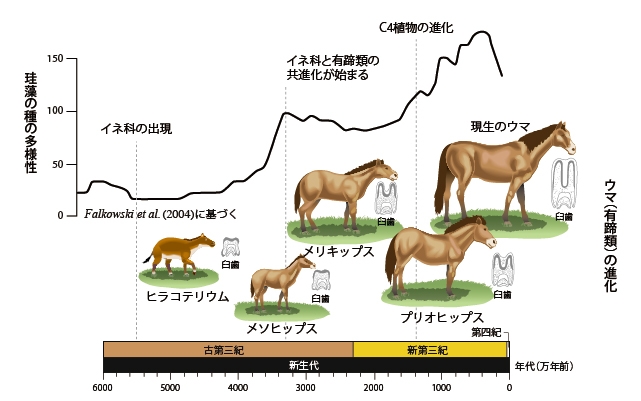
新第三紀は大陸と海の配置や山脈などの地理的特徴や、それに深く関係した気候が大きく変化して、現代に通じる土台が形成された時代である。例えば、ヒマラヤ・チベット山塊は古第三紀から引き続き上昇し、その結果モンスーン気候が強化された(参考:☞3ページ)。イタリアはフランスとスイスに衝突してアルプス山脈を形成し、スペインはフランスと衝突してピレネー山脈を隆起させた。また、北アメリカではロッキー山脈やシエラネバダ山脈、カスケード山脈が形成された。さらに、新第三紀の終わり近くには北アメリカと南アメリカの間にパナマ運河が形成され、北半球の寒冷化を促進した(☞E5_1)。日本はもともとアジア大陸の東端に位置していたが、新第三紀にアジア大陸から分離し、日本海も形作られた。
このように海陸の配置が変わり、陸上には標高の高い山脈が形成されたことによって大気循環が大きく変化した。このことは寒冷化を促進しただけではなく、乾燥化も引き起こした。特に中緯度では乾燥化が原因で、森林にかわって背丈の低い草原が拡大した。現在と同様に、こうした草原は主にイネ科の植物で構成された。イネ科の植物は硬いセルロースやプラントオパールと呼ばれるガラス質の粒子を作り出す。そのためイネ科の植物の葉は硬く食べにくい。それまで森林に生息していた多くの哺乳類は森林の減少に伴って草原に進出していたが、特に有蹄類はイネ科の植物を食べるための対策を歯に施し(例えば、馬は長い臼歯を発達させ)、勢力を拡大していった。
陸上にイネ科の草原が拡大したことは、海や湖沼の生態系にも影響を及ぼした。現在、それらの生態系において食物連鎖を底辺部から支えているのは、単細胞藻類の珪藻(☞E5_3)である。珪藻は新第三紀に(正確には古第三紀と新第三紀に2度)大きく進化をはたしたが、それらが陸上のイネ科植物や有蹄類の進化と同時期に起きたのである(イネ科植物・有蹄類・珪藻の「共進化」と呼ぶ)。イネ科の植物に含まれるプラントオパールは非生物性のオパールよりも水に溶けやすく、有蹄類が細かくかみ砕いた物ならなおさら水に溶けたであろう。それを効率的に利用することで、珪藻は躍進をとげたのである。
The Neogene is a period where sea and continental arrangement such as mountain ranges and the climate, which is deeply related to it, changed drastically and settled up the foundation of the world as we know it. For example, with the continuous rise of the Himalayas mountains since the Paleogene, the monsoon climate has been strengthened (Reference: ☞ Page 3). Italy collided with France and Switzerland to form the Alps Range, Spain collided with France to form the Pyrenees Mountains. In North America, the Rocky Mountains, the Sierra Nevada Mountains, and the Cascades Mountains were formed. Furthermore, at the end of the Neogene, the isthmus of Panama formed between North America and South America intensified the Northern Hemisphere cooling (☞E5_1).
Although, originally located at the eastern end of the Eurasian continent, Japan was separated from it during the Neogene and the Sea of Japan formed between the Asian continent and Japan.
As described previously, the land and sea arrangement changed, and the formation of high mountain ranges greatly changed the atmospheric circulation. This changed did not only caused climate's cooling but also caused its aridification. Due to this aridification, and especially at mid-latitudes, temperate grassland expanded at the expense of forest. Just as present day, these grasslands consisted primarily of Gramineae. Those Gramineae plants produce vitreous particles called phytolith or opal phytolith. Therefore, Gramineae leaves are hard and difficult to eat. Many mammals that lived in the forest until then had to move to the grassland when forests disappeared and forced to adapt to a Gramineae diet. For example, the ungulates, like horses, developed long molars to eat more efficiently Gramineae leaves.
Gramineae's expansion on land also affected lake and marine ecosystem. Currently, the food chained is supported at its bottom by single-celled algae called diatoms (☞E5_3). Those Diatoms evolved greatly in the Neogene period (to be exact, twice in the Paleogene and Neogene). However, it is interesting to notice that they evolved at the same time that Gramineae and Ungulates on land (called "gramineae, ungulates, diatoms co-evolution”). In fact, opal phytoliths contained in gramineae are more soluble in water than non-biological opals, and if they are finely chewed by ungulates, they become even more soluble in water. By utilizing efficiently those phytoliths, diatoms were able to make a breakthrough.